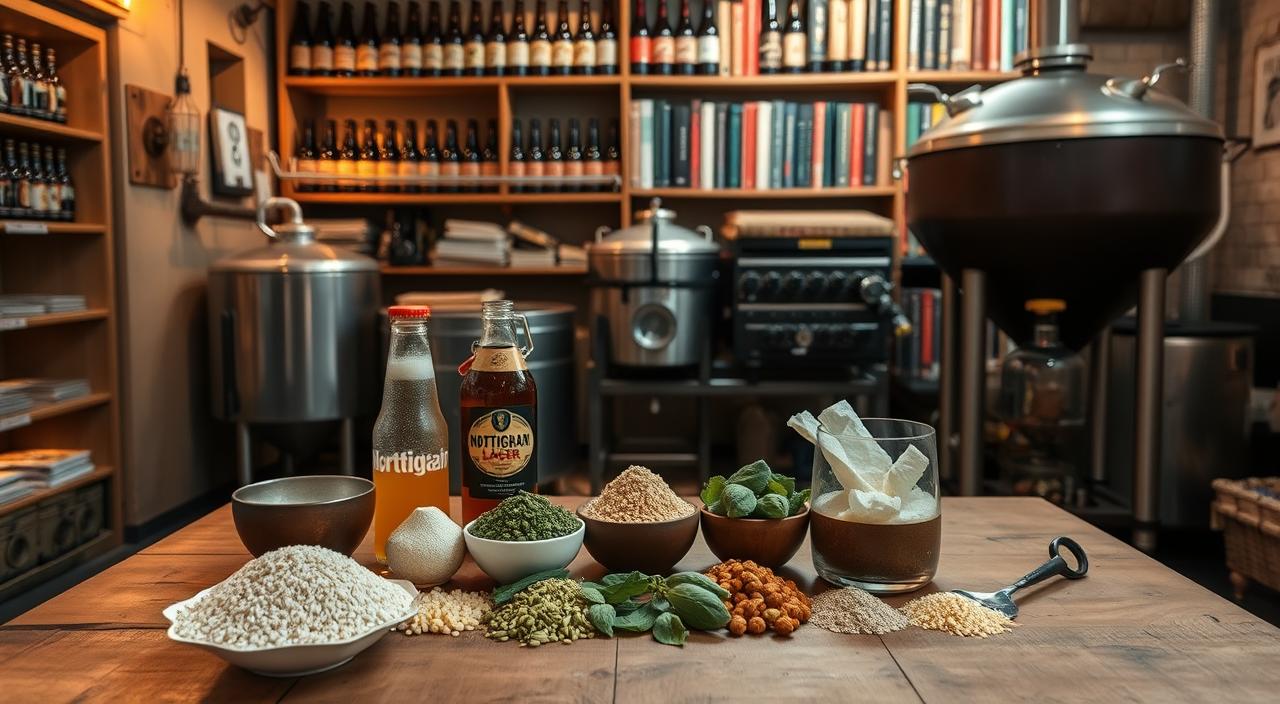Welcome to the world of brewing your own Nottingham lager! This guide will help you make your own lager. It’s perfect for both experienced brewers and beginners. You’ll learn how to pick ingredients, ferment, and bottle your own lager. Each step is explained to help you make a lager that honors traditional brewing.
Get ready to explore the history and ingredients of Nottingham lager. Learn about the equipment you’ll need and how to brew it. Soon, you’ll be enjoying the unique taste of Nottingham lager at home!
Key Takeaways
- Learn to brew your own Nottingham lager from scratch.
- Understand the historical roots of this classic lager.
- Identify key ingredients that contribute to its flavor profile.
- Follow a step-by-step brewing process for optimal results.
- Discover essential brewing equipment and sanitization methods.
- Get tips on fermentation and bottling techniques for the best outcomes.
Introduction to Nottingham Lager
In this introduction to Nottingham lager, let’s dive into what makes it special. This beer is loved for its crisp and clean taste. It has a golden color, perfect for many events. Knowing the brewing basics is key for fans of lager style beer.
This type of lager is unique within the lager family. It has a balanced body and flavor, making it refreshing. For more on traditional recipes, check out this ultimate guide on classic dishes that goes well with beer.
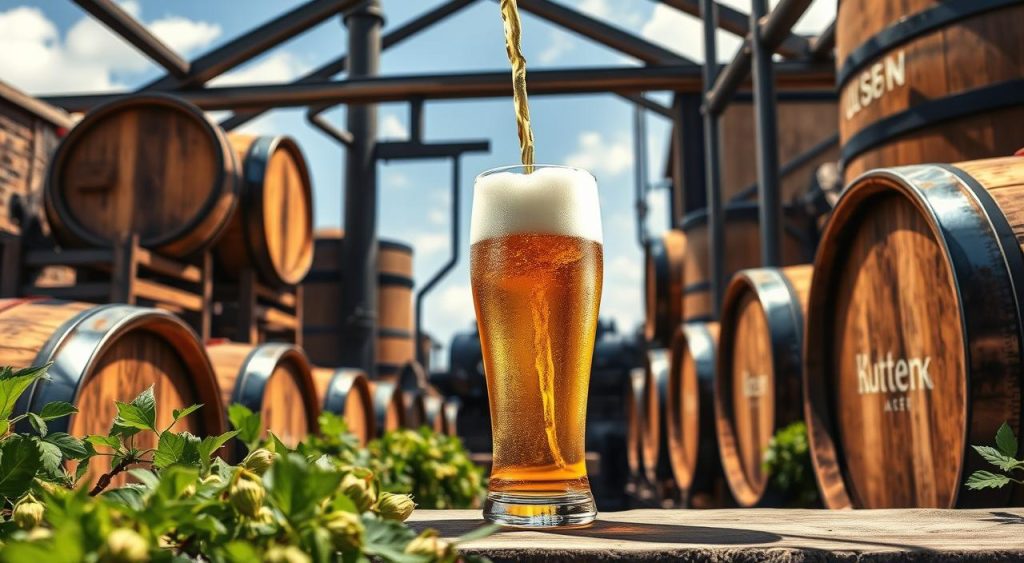
Nottingham lager offers a great drinking experience. It’s a top choice for lager lovers. By learning about its history and brewing, you’ll get to know more about your favorite beer.
History of Nottingham Lager
The story of Nottingham lager goes way back, tied to the area’s brewing history. Over time, brewing has changed a lot, making Nottingham a key spot for beer lovers.
Nottingham’s history shows it’s important in the beer evolution story. Local breweries tried new ways to make lager, creating unique recipes. These recipes were inspired by old brewing ways.
In the 19th century, Nottingham’s breweries were key in shaping lager. They used new ingredients and methods, adding to Nottingham’s lager history. Today, their influence still shapes beer trends and styles.
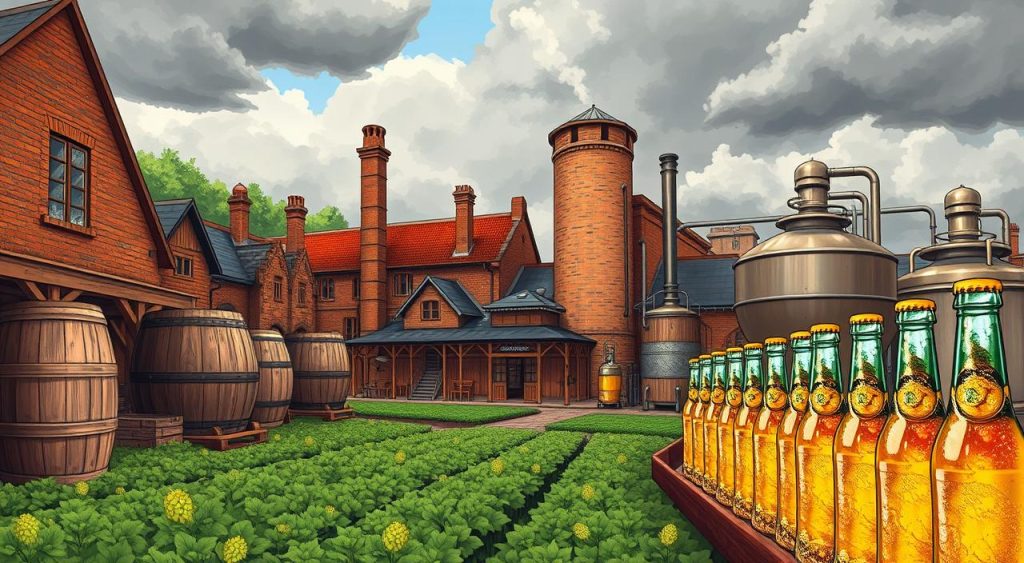
Old brewing logs and recipes give us a peek into the past. They show us the techniques and ingredients used back then. This history not only keeps the past alive but also inspires today’s brewers. They aim to capture the unique flavors of Nottingham lagers.
This deep tradition helps keep Nottingham lager popular. It makes sure it stays a part of the beer story.
Understanding the Ingredients
To make a great Nottingham lager, knowing the main ingredients is key. Each part plays a big role in the beer’s taste and character. Let’s look at the important parts of this classic beer.
Key Ingredients for Nottingham Lager
The main ingredients are malt, hops, water, and yeast. Choosing the right malt changes the beer’s taste, giving it a unique maltiness. Pale malt is often used, but a bit of caramel malt can add sweetness and color.
Choosing Your Hops
Hops are vital for balancing the beer’s sweetness. They also add to the smell and taste. Hops like Saaz or Hallertau are good choices for Nottingham lager. They have a mild bitterness and a floral taste. Adding hops at the right time can make the beer smell and taste even better.
Importance of Yeast in Brewing
Yeast is very important in brewing. Different yeast types give different flavors and smells, affecting the beer’s taste and clarity. For Nottingham lager, traditional yeast strains are best, leading to a clean finish. This makes yeast choice key to the beer’s quality.
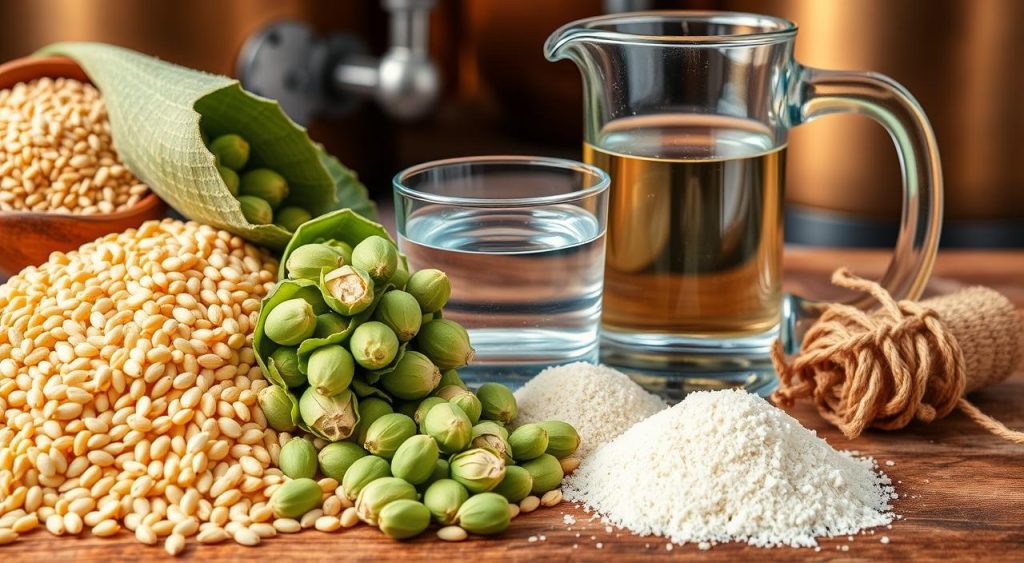
Nottingham Lager Recipe: Brew Your Own
Home brewing fans wanting to make their own Nottingham lager need a good recipe. This recipe calls for specific ingredients and a simple brewing process. Here’s a detailed guide to help you make this classic lager at home.
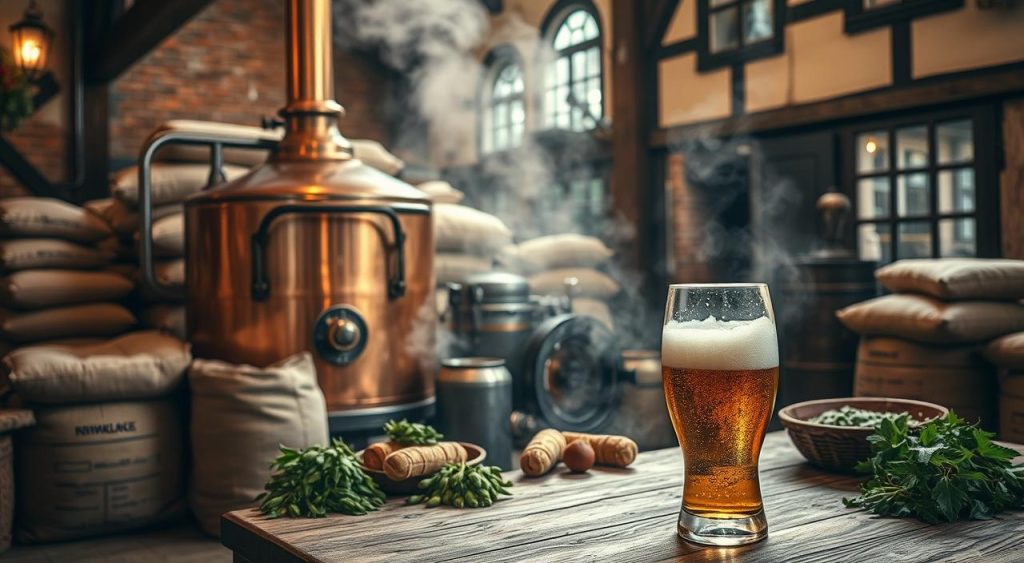
- 8 lbs Pilsner Malt
- 1 lb Carapils Malt
- 0.5 lb Munich Malt
- 1 oz Saaz hops (bittering)
- 0.5 oz Hallertau hops (flavor)
- 1 packet Nottingham yeast
- 5 gallons of water
Brewing Process:
- Mashing: Heat 3 gallons of water to about 165°F. Add the crushed grains and keep the temperature at 150°F for 60 minutes.
- Boiling: After draining, bring the wort to a boil. Add the bittering hops at the start and the flavor hops for the last 15 minutes.
- Cooling: Quickly cool the wort to about 70°F. Use a wort chiller or an ice bath.
- Fermentation: Transfer to a fermenter, pitch the yeast, and seal with an airlock. Allow it to ferment at around 65-70°F for about two weeks.
Follow this Nottingham lager brewing recipe for a tasty, handcrafted beer. Stick to the steps for a successful brew. Cheers to great beer!
Brewing Equipment You Will Need
To make your own Nottingham lager, you need the right brewing gear. High-quality home brew tools make brewing better and improve your beer’s taste. A good brewing station lets you control each step.
Essential Brewing Tools and Gear
Getting the right brewing equipment is key to making great lager. Here are the must-haves:
- Brew kettle: A large pot for boiling your wort.
- Fermenter: A vessel for allowing fermentation to take place.
- Hydrometer: This tool measures the specific gravity of your brew.
- Thermometer: Accurate temperature readings are crucial in brewing.
- Airlock: Essential for preventing contaminants from entering the fermenter.
With these tools, you’re ready for a successful brew.
Sanitization Methods
Sanitization is vital in brewing. It stops bacteria and wild yeast from ruining your beer. Use safe and effective sanitizers like iodophor or Star San. Here’s how to sanitize your gear:
- Clean all equipment with hot water and detergent.
- Soak items in a sanitizer solution for the right time.
- Rinse with boiled or distilled water to get rid of any sanitizer taste.
Keeping your tools clean leads to better brewing results. For more recipes and tips, visit this useful page.
The Brewing Process
The brewing process turns simple ingredients into a tasty drink. It’s key for both new and seasoned brewers. We’ll go through the steps and talk about common problems you might face.
Step-by-Step Brewing Instructions
Starting your brew needs focus on details. Here are the steps for a great brew:
- Preparation of the Wort: Start by heating water and mixing in malt. Stir well to soak all grains.
- Boiling: Heat the wort to the right temperature, then boil it. Add hops as your recipe says for taste and bitterness.
- Cooling: Cool the wort fast to the right temperature for yeast. Use an immersion chiller for this.
- Fermentation Transfer: Move the cooled wort to a fermenter without letting in germs.
- Yeast Addition: Put the yeast in the fermenter and seal it. Watch for fermentation to start.
Troubleshooting Common Issues
During brewing, things can go wrong. Here are ways to fix common problems:
- Off-Flavors: Bad tastes might mean your cleaning wasn’t good enough or your ingredients were poor quality.
- Low Carbonation: Not enough priming sugar can cause this. Make sure you use the right amount when bottling.
- Stuck Fermentation: If yeast isn’t active, fermentation can stop. Try stirring the fermenter gently to wake up the yeast.
Follow the steps and use these tips to improve your brewing. You’ll make a tasty Nottingham Lager.
Fermentation Tips
Mastering the fermentation process is key to making great Nottingham lager. It greatly affects the taste and quality of your beer. By following top lager fermentation tips, you can improve yeast performance and the beer’s character.
Begin by keeping the temperature right, between 50°F and 55°F. This is perfect for Nottingham yeast to work its best. If the temperature changes, it can make your beer taste bad and be cloudy. It’s also important to watch how long fermentation lasts, usually one to two weeks.
Checking the specific gravity during fermentation is a must. It shows how the fermentation is going and if the yeast is doing its job. Learning about the yeast’s traits, like how much sugar it can use and how it clumps, helps you understand fermentation better.
Remember, oxygen affects fermentation too. Adding a bit of oxygen before adding yeast helps the yeast work well. This is crucial for making great beer at home. By following these tips, you can make a delicious Nottingham lager.
Bottling Your Nottingham Lager
Once your Nottingham lager is ready, it’s time to bottle it. This step keeps your brew fresh and lets you enjoy a great finish. Getting bottling right is important for keeping your lager’s taste and character. There are a few things to think about.
Choosing the Right Bottles
The type of bottles you use matters a lot. Glass bottles are a top pick for home brewers because they keep out light and help with carbonation. If you want something more flexible, plastic bottles work well for short-term storage. Make sure they’re clean before filling to avoid contamination.
Carbonation Techniques
You can choose between natural and forced carbonation for your lager. Natural carbonation uses priming sugar and lets yeast make carbon dioxide in the bottle. This method gives a smooth fizz that goes well with the lager’s taste.
Forced carbonation, on the other hand, uses a CO2 tank for more control over the fizz. Pick the method that suits you and your setup. Remember to label your bottles so you can tell them apart. Then, get ready to enjoy what you’ve made!
FAQ
What is Nottingham lager?
Nottingham lager is a crisp and clean beer with a golden color. It’s a type of lager known for being refreshing. Beer lovers enjoy its taste.
How do I brew my own Nottingham lager at home?
You need malt, hops, water, and yeast to brew Nottingham lager at home. Use a recipe that shows you how to mash, boil, ferment, and bottle. This way, you’ll get the traditional flavor.
What equipment do I need for home brewing Nottingham lager?
You’ll need a brew kettle, fermenter, hydrometer, and tools for cleaning. Having the right tools helps with a good brew and keeps things clean.
What are some tips for successful fermentation?
For good fermentation, watch the yeast and how the beer changes. Keep the temperature right, control fermentation time, and check the gravity often. This helps get the flavor you want.
How should I carbonate my Nottingham lager?
You can use natural or forced carbonation for your lager. Choose the right bottles, like glass or plastic, to help with carbonation. This makes your beer fizzy when you pour it.
What are common mistakes to avoid when brewing Nottingham lager?
Don’t forget to clean your equipment and keep an eye on the temperature during fermentation. Also, make sure to check the carbonation levels. Paying attention at each step helps avoid bad flavors and makes your lager better.
Can I use different hop varieties in my Nottingham lager?
Yes, trying different hops can make your lager taste better. Pick hops that go well with the malt and fit the lager style you like.

